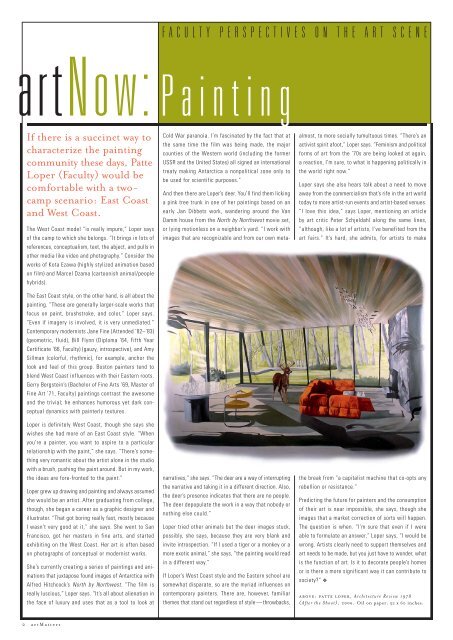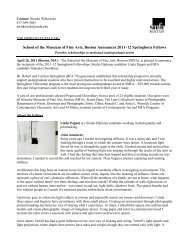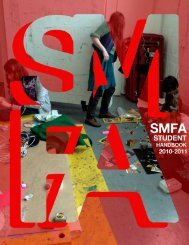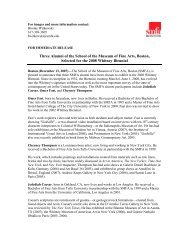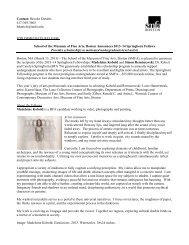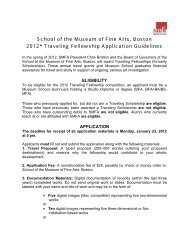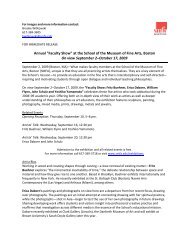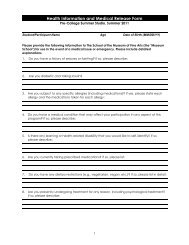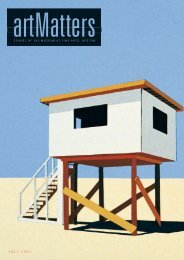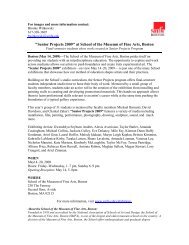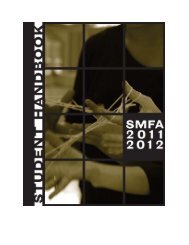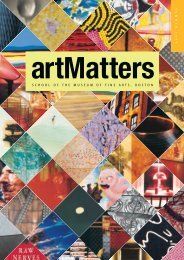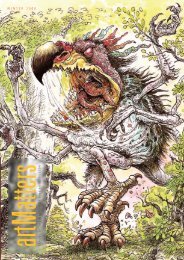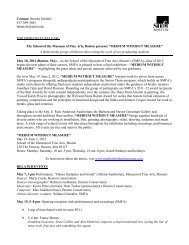41786 artMattersV2 - School of the Museum of Fine Arts
41786 artMattersV2 - School of the Museum of Fine Arts
41786 artMattersV2 - School of the Museum of Fine Arts
Create successful ePaper yourself
Turn your PDF publications into a flip-book with our unique Google optimized e-Paper software.
FACULTY PERSPECTIVES ON THE ART SCENE<br />
artNow:Painting<br />
If <strong>the</strong>re is a succinct way to<br />
characterize <strong>the</strong> painting<br />
community <strong>the</strong>se days, Patte<br />
Loper (Faculty) would be<br />
comfortable with a twocamp<br />
scenario: East Coast<br />
and West Coast.<br />
The West Coast model “is really impure,” Loper says<br />
<strong>of</strong> <strong>the</strong> camp to which she belongs. “It brings in lots <strong>of</strong><br />
references, conceptualism, text, <strong>the</strong> abject, and pulls in<br />
o<strong>the</strong>r media like video and photography.” Consider <strong>the</strong><br />
works <strong>of</strong> Kota Ezawa (highly stylized animation based<br />
on film) and Marcel Dzama (cartoonish animal/people<br />
hybrids).<br />
The East Coast style, on <strong>the</strong> o<strong>the</strong>r hand, is all about <strong>the</strong><br />
painting. “These are generally larger-scale works that<br />
focus on paint, brushstroke, and color,” Loper says.<br />
“Even if imagery is involved, it is very unmediated.”<br />
Contemporary modernists Jane <strong>Fine</strong> (Attended ’82–’83)<br />
(geometric, fluid), Bill Flynn (Diploma ’64, Fifth Year<br />
Certificate ’66, Faculty) (gauzy, introspective), and Amy<br />
Sillman (colorful, rhythmic), for example, anchor <strong>the</strong><br />
look and feel <strong>of</strong> this group. Boston painters tend to<br />
blend West Coast influences with <strong>the</strong>ir Eastern roots.<br />
Gerry Bergstein’s (Bachelor <strong>of</strong> <strong>Fine</strong> <strong>Arts</strong> ’69, Master <strong>of</strong><br />
<strong>Fine</strong> Art ’71, Faculty) paintings contrast <strong>the</strong> awesome<br />
and <strong>the</strong> trivial; he enhances humorous yet dark conceptual<br />
dynamics with painterly textures.<br />
Loper is definitely West Coast, though she says she<br />
wishes she had more <strong>of</strong> an East Coast style. “When<br />
you’re a painter, you want to aspire to a particular<br />
relationship with <strong>the</strong> paint,” she says. “There’s something<br />
very romantic about <strong>the</strong> artist alone in <strong>the</strong> studio<br />
with a brush, pushing <strong>the</strong> paint around. But in my work,<br />
<strong>the</strong> ideas are fore-fronted to <strong>the</strong> paint.”<br />
Loper grew up drawing and painting and always assumed<br />
she would be an artist. After graduating from college,<br />
though, she began a career as a graphic designer and<br />
illustrator. “That got boring really fast, mostly because<br />
I wasn’t very good at it,” she says. She went to San<br />
Francisco, got her masters in fine arts, and started<br />
exhibiting on <strong>the</strong> West Coast. Her art is <strong>of</strong>ten based<br />
on photographs <strong>of</strong> conceptual or modernist works.<br />
She’s currently creating a series <strong>of</strong> paintings and animations<br />
that juxtapose found images <strong>of</strong> Antarctica with<br />
Alfred Hitchcock’s North by Northwest. “The film is<br />
really luscious,” Loper says. “It’s all about alienation in<br />
<strong>the</strong> face <strong>of</strong> luxury and uses that as a tool to look at<br />
Cold War paranoia. I’m fascinated by <strong>the</strong> fact that at<br />
<strong>the</strong> same time <strong>the</strong> film was being made, <strong>the</strong> major<br />
counties <strong>of</strong> <strong>the</strong> Western world (including <strong>the</strong> former<br />
USSR and <strong>the</strong> United States) all signed an international<br />
treaty making Antarctica a nonpolitical zone only to<br />
be used for scientific purposes.”<br />
And <strong>the</strong>n <strong>the</strong>re are Loper’s deer. You’ll find <strong>the</strong>m licking<br />
a pink tree trunk in one <strong>of</strong> her paintings based on an<br />
early Jan Dibbets work, wandering around <strong>the</strong> Van<br />
Damm house from <strong>the</strong> North by Northwest movie set,<br />
or lying motionless on a neighbor’s yard. “I work with<br />
images that are recognizable and from our own metanarratives,”<br />
she says. “The deer are a way <strong>of</strong> interrupting<br />
<strong>the</strong> narrative and taking it in a different direction. Also,<br />
<strong>the</strong> deer’s presence indicates that <strong>the</strong>re are no people.<br />
The deer depopulate <strong>the</strong> work in a way that nobody or<br />
nothing else could.”<br />
Loper tried o<strong>the</strong>r animals but <strong>the</strong> deer images stuck,<br />
possibly, she says, because <strong>the</strong>y are very blank and<br />
invite introspection. “If I used a tiger or a monkey or a<br />
more exotic animal,” she says, “<strong>the</strong> painting would read<br />
in a different way.”<br />
If Loper’s West Coast style and <strong>the</strong> Eastern school are<br />
somewhat disparate, so are <strong>the</strong> myriad influences on<br />
contemporary painters. There are, however, familiar<br />
<strong>the</strong>mes that stand out regardless <strong>of</strong> style —throwbacks,<br />
almost, to more socially tumultuous times. “There’s an<br />
activist spirit afoot,” Loper says. “Feminism and political<br />
forms <strong>of</strong> art from <strong>the</strong> ’70s are being looked at again,<br />
a reaction, I’m sure, to what is happening politically in<br />
<strong>the</strong> world right now.”<br />
Loper says she also hears talk about a need to move<br />
away from <strong>the</strong> commercialism that’s rife in <strong>the</strong> art world<br />
today to more artist-run events and artist-based venues.<br />
“I love this idea,” says Loper, mentioning an article<br />
by art critic Peter Schjeldahl along <strong>the</strong> same lines,<br />
“although, like a lot <strong>of</strong> artists, I’ve benefited from <strong>the</strong><br />
art fairs.” It’s hard, she admits, for artists to make<br />
<strong>the</strong> break from “a capitalist machine that co-opts any<br />
rebellion or resistance.”<br />
Predicting <strong>the</strong> future for painters and <strong>the</strong> consumption<br />
<strong>of</strong> <strong>the</strong>ir art is near impossible, she says, though she<br />
images that a market correction <strong>of</strong> sorts will happen.<br />
The question is when. “I’m sure that even if I were<br />
able to formulate an answer,” Loper says, “I would be<br />
wrong. Artists clearly need to support <strong>the</strong>mselves and<br />
art needs to be made, but you just have to wonder, what<br />
is <strong>the</strong> function <strong>of</strong> art. Is it to decorate people’s homes<br />
or is <strong>the</strong>re a more significant way it can contribute to<br />
society?” ❖<br />
above: patte loper, Architecture Review 1978<br />
(After <strong>the</strong> Shoot), 2006. Oil on paper. 52 x 60 inches.<br />
2 artMatters


